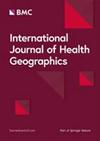中国特大城市出租车司机如何暴露于细颗粒物(PM2.5):结合卫星信息和城市交通数据的快速评估
IF 3
2区 医学
Q2 PUBLIC, ENVIRONMENTAL & OCCUPATIONAL HEALTH
引用次数: 0
摘要
由于工作性质、繁忙的道路交通和城市密度,中国某特大城市的出租车司机经常暴露于与交通相关的颗粒物(PM2.5)中。采用一种可靠的方法来量化出租车司机的 PM2.5 动态人群暴露量对于职业风险预防非常重要,但这一方法受到数据可用性的限制。本研究提出了一种基于卫星衍生信息、监测站空气质量数据和基于 GPS 的出租车轨迹数据的司机 PM2.5 动态暴露快速评估方法。在中国武汉开展了一项实证研究,以考察动态暴露的时空变异性,并比较司机的暴露量是否超过了世界卫生组织(WHO)和中国空气质量指南的阈值。为了进一步探讨动态暴露与出租车司机活动之间的关系,研究人员进行了核密度估计。出租车司机平日和周末 24 小时 PM2.5 暴露量分别为 83.60 μg/m3 和 55.62 μg/m3,分别是世界卫生组织建议水平 25 µg/m3 的 3.4 倍和 2.2 倍。具体而言,PM2.5暴露量高的驾驶员平均行程距离较长,活动区域较小。虽然主要交通枢纽/终点站是暴露量高和暴露量低的出租车司机的共同活动热点,但暴露量高的司机的活动热点主要位于以 "内环路 "为界的历史中心区的繁华滨河商业区,而暴露量低的司机的活动热点则位于以 "三环路 "为界的城市化扩展区的新兴商业区。这些发现强调了空气质量管理和社区规划的必要性,以减轻出租车司机潜在的健康风险。本文章由计算机程序翻译,如有差异,请以英文原文为准。
How do taxi drivers expose to fine particulate matter (PM2.5) in a Chinese megacity: a rapid assessment incorporating with satellite-derived information and urban mobility data
Taxi drivers in a Chinese megacity are frequently exposed to traffic-related particulate matter (PM2.5) due to their job nature, busy road traffic, and urban density. A robust method to quantify dynamic population exposure to PM2.5 among taxi drivers is important for occupational risk prevention, however, it is limited by data availability. This study proposed a rapid assessment of dynamic exposure to PM2.5 among drivers based on satellite-derived information, air quality data from monitoring stations, and GPS-based taxi trajectory data. An empirical study was conducted in Wuhan, China, to examine spatial and temporal variability of dynamic exposure and compare whether drivers’ exposure exceeded the World Health Organization (WHO) and China air quality guideline thresholds. Kernel density estimation was conducted to further explore the relationship between dynamic exposure and taxi drivers’ activities. The taxi drivers’ weekday and weekend 24-h PM2.5 exposure was 83.60 μg/m3 and 55.62 μg/m3 respectively, 3.4 and 2.2 times than the WHO’s recommended level of 25 µg/m3. Specifically, drivers with high PM2.5 exposure had a higher average trip distance and smaller activity areas. Although major transportation interchanges/terminals were the common activity hotspots for both taxi drivers with high and low exposure, activity hotspots of drivers with high exposure were mainly located in busy riverside commercial areas within historic and central districts bounded by the “Inner Ring Road”, while hotspots of drivers with low exposure were new commercial areas in the extended urbanized area bounded by the “Third Ring Road”. These findings emphasized the need for air quality management and community planning to mitigate the potential health risks of taxi drivers.
求助全文
通过发布文献求助,成功后即可免费获取论文全文。
去求助
来源期刊

International Journal of Health Geographics
PUBLIC, ENVIRONMENTAL & OCCUPATIONAL HEALTH -
CiteScore
10.20
自引率
2.00%
发文量
17
审稿时长
12 weeks
期刊介绍:
A leader among the field, International Journal of Health Geographics is an interdisciplinary, open access journal publishing internationally significant studies of geospatial information systems and science applications in health and healthcare. With an exceptional author satisfaction rate and a quick time to first decision, the journal caters to readers across an array of healthcare disciplines globally.
International Journal of Health Geographics welcomes novel studies in the health and healthcare context spanning from spatial data infrastructure and Web geospatial interoperability research, to research into real-time Geographic Information Systems (GIS)-enabled surveillance services, remote sensing applications, spatial epidemiology, spatio-temporal statistics, internet GIS and cyberspace mapping, participatory GIS and citizen sensing, geospatial big data, healthy smart cities and regions, and geospatial Internet of Things and blockchain.
 求助内容:
求助内容: 应助结果提醒方式:
应助结果提醒方式:


